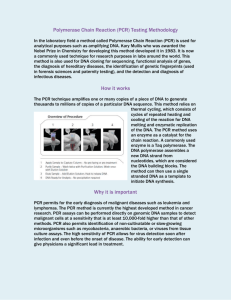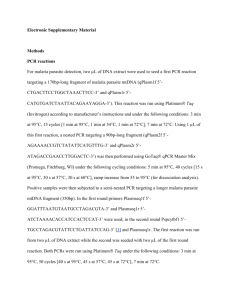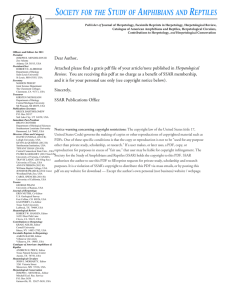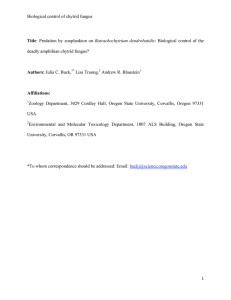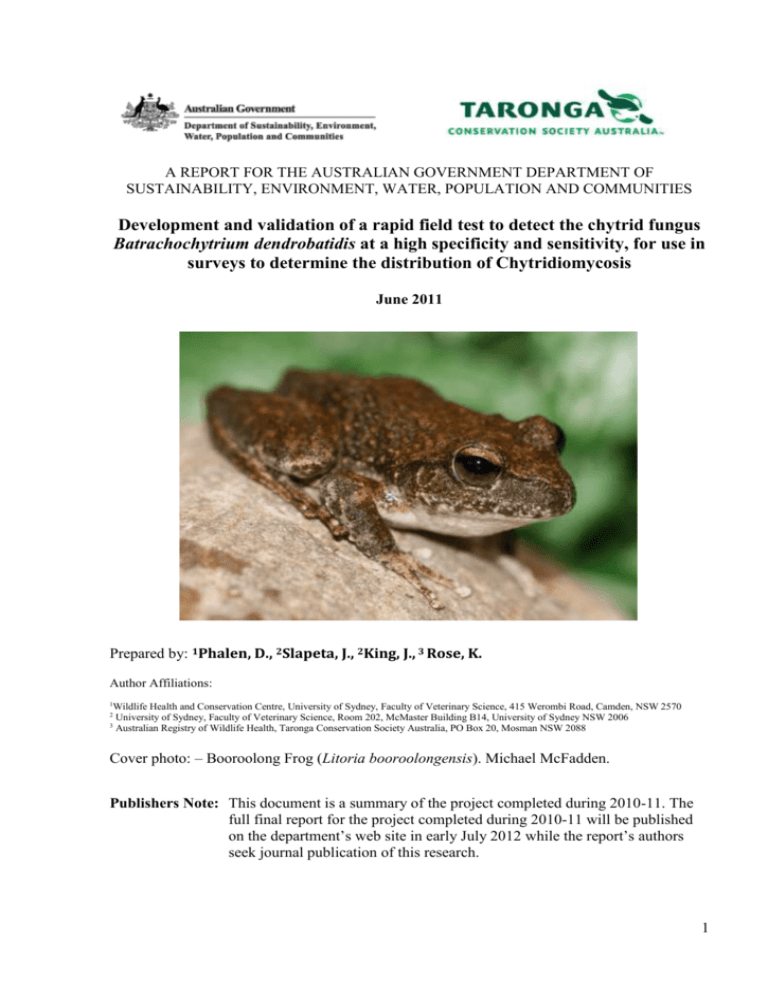
A REPORT FOR THE AUSTRALIAN GOVERNMENT DEPARTMENT OF
SUSTAINABILITY, ENVIRONMENT, WATER, POPULATION AND COMMUNITIES
Development and validation of a rapid field test to detect the chytrid fungus
Batrachochytrium dendrobatidis at a high specificity and sensitivity, for use in
surveys to determine the distribution of Chytridiomycosis
June 2011
Prepared by: 1Phalen, D., 2Slapeta, J., 2King, J., 3 Rose, K.
Author Affiliations:
1
Wildlife Health and Conservation Centre, University of Sydney, Faculty of Veterinary Science, 415 Werombi Road, Camden, NSW 2570
University of Sydney, Faculty of Veterinary Science, Room 202, McMaster Building B14, University of Sydney NSW 2006
3
Australian Registry of Wildlife Health, Taronga Conservation Society Australia, PO Box 20, Mosman NSW 2088
2
Cover photo: – Booroolong Frog (Litoria booroolongensis). Michael McFadden.
Publishers Note: This document is a summary of the project completed during 2010-11. The
full final report for the project completed during 2010-11 will be published
on the department’s web site in early July 2012 while the report’s authors
seek journal publication of this research.
1
© Commonwealth of Australia (2011).
The views and opinions expressed in this publication are those of the authors and do not necessarily reflect those of
the Australian Government or the Minister for Sustainability, Environment, Water, Population and Communities.
While reasonable efforts have been made to ensure that the contents of this publication are factually correct, the
Commonwealth does not accept responsibility for the accuracy or completeness of the contents, and shall not be
liable for any loss or damage that may be occasioned directly or indirectly through the use of, or reliance on, the
contents of this publication.
This work is copyright. You may download, display, print and reproduce this material in unaltered form only (retaining
this notice) for your personal, non-commercial use or use within your organisation. Apart from any use as permitted
under the Copyright Act 1968, all other rights are reserved. Requests and enquiries concerning reproduction and
rights should be addressed to Department of Sustainability, Environment, Water, Populations and Communities,
Public Affairs, GPO Box 787 Canberra ACT 2601 or email public.affairs@environment.gov.au.
Funding for this project (Procurement Reference Number: 1011-0655) was provided by the Australian Government
Department for Sustainability, Environment, Water, Population and Communities. This project progresses the
implementation of the Threat abatement plan for infection of amphibians with chytrid fungus resulting in
chytridiomycosis (Commonwealth of Australia, 2006).
This report should be cited as:
Phalen, D., Slapeta, J., King, J., Rose, K. (2011). Development and validation of a rapid field test to detect the
chytrid fungus Batrachochytrium dendrobatidis at a high specificity and sensitivity, for use in surveys to
determine the distribution of Chytridiomycosis. Australian Registry of Wildlife Health, Taronga Conservation
Society Australia, Mosman New South Wales. A report for the Australian Government Department of
Sustainability, Environment, Water, Population and Communities.
2
Project Background and Objectives
The purpose of this study was to develop and validate a rapid, accurate and user-friendly test to
apply to environmental samples to identify potential pathogens, such as the chytrid fungus
Batrachochytrium dendrobatidis, that may be present in low concentrations.
This waterborne fungus is highly pathogenic to some amphibians and has been identified as a
significant cause of amphibian population declines and species extinctions [DEH 2006,
Kirshtein et al. 2007, Skerratt et al. 2007]. Extensive research into the impacts of this fungus
within Australia has lead to the organism being identified as a key process threatening our
amphibian biodiversity [DEH 2006].
A deoxyribonucleic acid (DNA) amplification technology, known as Loop-Mediated Isothermal
Amplification (LAMP) has been proposed to have many advantages over polymerase chain
reaction (PCR) while retaining a high level of sensitivity. LAMP amplification occurs at a single
temperature and therefore can be done in an easily transported heating block. LAMP technology
uses a strand displacing DNA polymerase in combination with target specific primers to produce
large quantities of target DNA. In so doing, pyrophosphate ions are released that react to form a
white precipitate of magnesium pyrophosphate. Positive samples can then be identified with a
turbidity meter or, potentially, with the naked eye [10]. LAMP technology has the added
advantage in that it is not impacted by inhibitors the same way that the DNA polymerases used
in PCR reactions are. Thus, relatively simple ways of releasing DNA (e. g., boiling) can be used
to prepare samples for testing with LAMP.
Summary of Materials and Methods
DNA was extracted from two cultures of B. dendrobatidis to validate traditional PCR tests and
LAMP assays using four sets of B. dendrobatidis-specific primers. Water samples were
collected from varied amphibian habitats along the coast of NSW. Some of these environments
were known to be affected with the B. dendrobatidis fungus. Water samples were collected with
a peristaltic pump and filtered. DNA was extracted from the water filters and the extracted
materials were subject to PCR and LAMP analysis.
Summary of Results
Conventional PCR performed on the two cultures using the two outer primers from all four
LAMP primer sets and subsequent sequencing of the PCR products confirmed that the primers
selected for the LAMP assays were specific for B. dendrobatidis detection.
Species-specific PCR performed on the DNA extracted from water filtrate extracted DNA
samples found that none of the environmental samples were positive for chytrid DNA when
conventional PCR was applied. However, when the LAMP assays were applied to the water
filtrate DNA samples, the LAMP assays rapidly detected B. dendrobatidis DNA in 30% (3/10)
of the water filtrate extracted DNA samples tested. This positive detection was characterised by
the ladder pattern when run on an agarose gel.
3
Summary of Discussion
In this present study we have developed a rapid test to detect the chytrid fungus B. dendrobatidis
at a high specificity and sensitivity and have demonstrated that this test appears to be more
sensitive at detecting the fungus in environmental water samples compared with conventional
species-specific PCR techniques. The benefits of LAMP include that it is less prone to the
presence of irrelevant DNA than PCR, it amplifies DNA with a high efficiency, is highly
specific for the target sequence and is quick and easy to perform using only a heat block or a
water bath (Notomi et al., 2000). Published claims that the LAMP test can be applied in the field
as DNA products are visible with the naked eye were not repeatable within this study.
Additional studies are underway to further validate and optimise this LAMP test.
References
Annis, S.L., Dastoor, F.P., Ziel, H., Daszak, P., Longcore, J.E., 2004, A DNA-based assay
identifies Batrachochytrium dendrobatidis in amphibians. J Wildl Dis 40, 420-428.
DEH (2006) Infection of amphibians with chytrid fungus resulting in chytridiomycosis.
Department of the Environment and Heritage. ISBN 0 6425 5029 8
Kirshtein, J. D. et al. (2007) Quantitative PCR detection of Batachochtrium dendrobatidis DNA
from sediments and water. Diseases of Aquatic Organisms 77, 11-15
Skerratt, L.F., et al. (2007) Spread of chytridiomycosis has caused the rapid global decline and
extinction of frogs. Eco Health 4, 125-134.
Notomi, T., Okayama, H., Masubuchi, H., Yonekawa, T., Watanabe, K., Amino, N., Hase, T.,
2000, Loop-mediated isothermal amplification of DNA. Nucleic Acids Res 28, E63.
4






